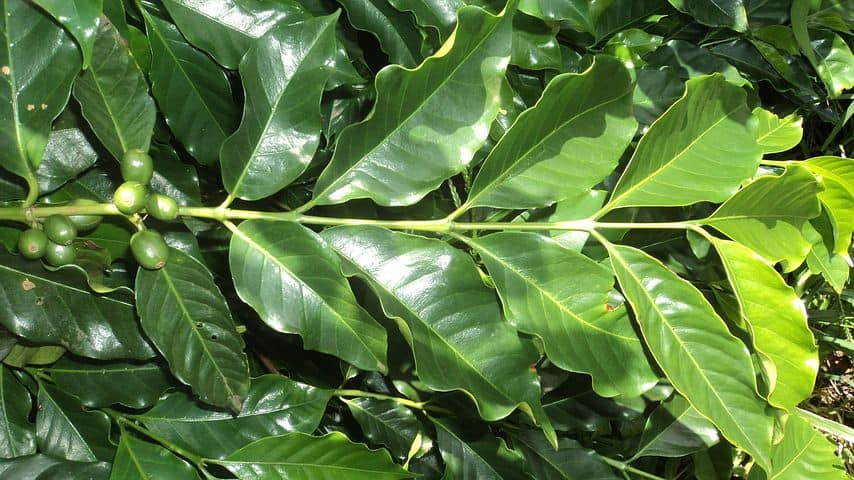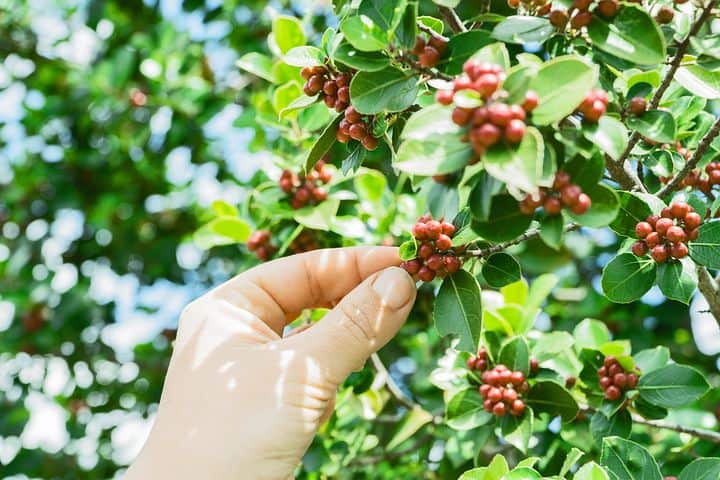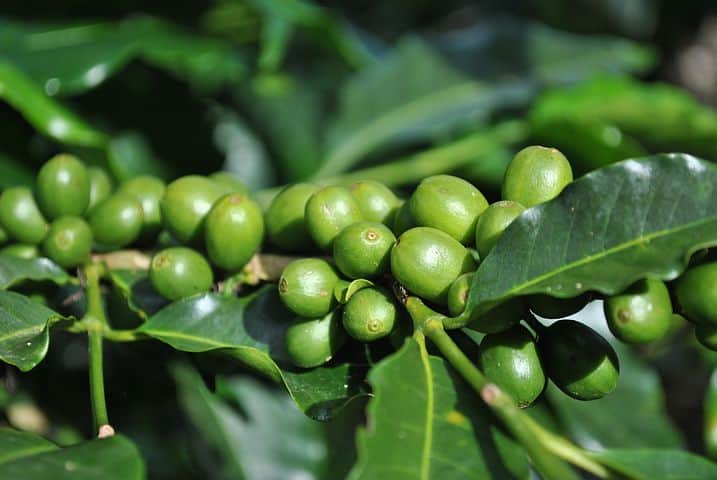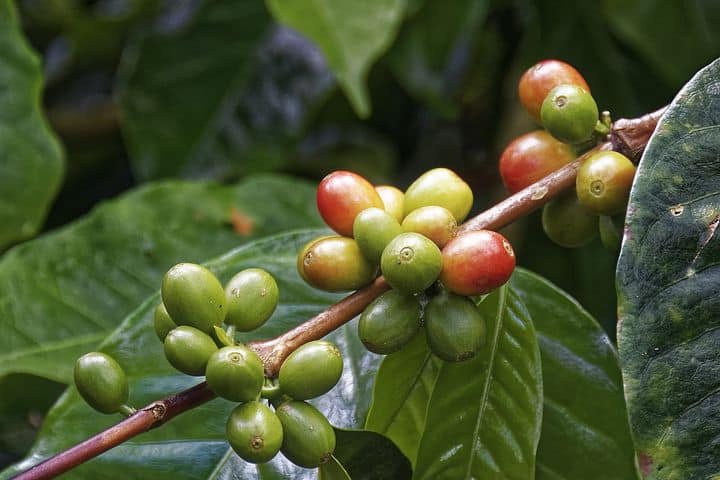Last Updated on May 19, 2023 by a Friendly Gardener
Shiny, deep-green-hued foliage explains why the lovely coffee plant is not only cultivated for the morning brew but as a beautiful houseplant as well.
The Coffea arabica (Arabian coffee)finds its native habitat in Ethiopia. Its genus coffea refers to the Arabicqahwameaning “beverage”. These plants mature into medium-sized trees in their natural environment. Coffee growers instead prune these plants to more manageable sizes. Indoor cultivation requires pruning to contain growth.
Start your coffee plants in early spring. Although they are hardy and robust growers, flowering and producing fruit need several years.
Coffee plants will bloom in spring and tiny white flowers will appear. Half-inch-sized green berries will follow. During maturation, they turn yellow, then a light red hue only to gradually become darker until they appear as black pods.
Coffee plant berries are not edible. Each coffee pod hosts two seeds that will be extracted. Seeds are placed in the sun to dry. Once dried, they can be roasted. Roasted coffee beans are used to brew your favorite morning coffee.
Coffee Plant Care

An impressive evergreen perennial, the coffee plant can grow to heights and widths of fifteen feet tall. This plant’s natural habitat is a tropical hillside at mid-elevation. So, when cultivating, it becomes imperative to reproduce these conditions in some measure. A rich, slightly acidic soil bed featuring good drainage and generous watering, high humidity, and somewhat cooler temperatures will be part of the equation.
If you live in an area that replicates this type of environment, you can cultivate the coffee plant outdoors. To cultivate a coffee plant as a houseplant, it will require bright indirect light, and never direct sunlight exposure together with a consistently moist soil bed. Keep your coffee plant at a distance from potential drafty spots and air conditioning vents.
Soil
Use peat-based potting soil for exceptional drainage. Coffee plants prefer slightly acidic and rich potting soil. If your plant looks under the weather, increase the soil pH by adding organic matter. Sphagnum peat moss is ideal for this. Coffee plants grow in a soil bed with a pH level between 4 and 7, but a 6 to 6.5 pH is ideal.
Light
The coffee plant generally grows below other types of plants and vegetation, so dappled sunlight is best. They do not flourish in harsh sunlight. When overexposed, the foliage begins to brown.
Water and Humidity

This is a plant that needs generous watering on a schedule. The soil must be kept evenly moist without becoming waterlogged. It should not dry out completely.
The coffee plant demands high humidity levels as it grows in tropical humid conditions that feature rain as well as fog. Indoors, humidity should measure above 50%. If the Coffee plant is grown in dry air, leaf edges will brown. A space humidifier is ideal and misting every few days can help.
A pebble tray is an alternative for raising localized humidity. Place pebbles in a shallow tray and add water. Place your Coffee Plant on top of the pebble-filled tray. The bottom of the container should not touch the water in the tray. The water in the tray will gradually evaporate, adding moisture to the surrounding air.
Coffee plants do exceptionally well in bathrooms and kitchens where humidity is usually higher. You can also group together plants. As they transpire, humidity levels will raise in the area of the plants.
Temperature
Daytime temperatures should measure between 70° and 80° Fahrenheit. Evenings can drop to approximately 65°F. When cultivated in higher temperatures, coffee plants grow more rapidly but this is not good for bean production. Beans need gradual ripening to ensure quality.
Feeding
A weak, diluted liquid fertilizer should be applied every two weeks during the growing season. In the winter, feed monthly.
Pruning

As Coffee plants grow as much as fifteen feet in height, pruning becomes an essential part of plant care. This is not a manageable size for most indoor locations. When still a manageable size, pinch off new growth to contain the height and encourage a bushier plant form.
Large plants will most likely need to be cut back. Radical pruning does not harm this plant. Prune in the spring using sterile sharp gardening shears. Snip the stem at a 45° angle above a leaf attachment. Top plant growth for height control. Remove offshoots and dying branches. Large limbs should be left. Pruning cuttings can be used for Coffee Plants propagation.
Repotting
Repot your Coffee plant every spring in a pot one size larger with an adequate number of drainage holes. Another method for containing plant size is to trim roots back during repotting.
Coffee Plant Propagation

To propagate a Coffee Plant, acquire seeds from a garden center or use your seeds from a plant you have. Coffee plants can be propagated with stem cuttings or air layers.
In early summer take a cutting. Choose a straight shoot approximately 10 long. Leave only the upper two leaves and remove all others. Place the cutting in a small container of soilless potting mix. Soil beds should remain moist until roots have formed.
Coffee Plant Toxicity
The entire Coffee plant is considered toxic for cats, dogs, horses, and birds among others. It is also toxic to humans, except for mature fruit, the coffee bean. Common poisoning symptoms include:
- Vomiting
- Nausea
- Diarrhea
- Lack of appetite
Severe poisoning can produce an irregular heartbeat and seizures. Severe poisoning for animals is often lethal. Horses are particularly at risk during grazing. Severe poisoning in humans will not usually lead to death.
If any part of the Coffee Plant, other than the dried coffee bean, is chewed, eaten, or swallowed, contact a medical doctor, veterinarian, or local poison control center immediately. Yellow or red berries should not be eaten. Coffee beans can be ingested.
Pests, Diseases, and Problems
Indoor Coffee Plants can, like most indoor houseplants, suffer infestations of aphids, mites, and mealybugs. White cotton-like deposits, or small spider webs, are a tell-tale sign you need to treat the plant. Infestations can spread. Use organic insecticidal soap or Neem oil. Should this fail, use a chemical insecticide.
Coffee Bean Harvest

When cultivating a Coffee Bean plant indoors, these are usually grown for ornamental purposes and not for bean production. You can however harvest your plant’s berries. Berries will be produced after your plant has matured. This can take from three to five years.
When your plant’s berries have ripened to deep red and are soft, pinche them off the plant by hand. Pulp the berries in a container of water and remove the coffee beans from within.
Place the harvested beans on a woven mesh rack to be dried. This may require days to weeks as the beans must be sufficiently dried for their skin to easily flake off. You can now grind your coffee beans in a coffee mill and enjoy your own home-grown, home-brewed coffee.
There are over 120 different plant species in the Coffea genus, among which you’ll find:

- Coffea canephora hails from sub-Saharan Africa. These are robust plants but offer a harsher, stronger taste.
- Coffea eugenioides which originates in East Africa and has beans with lower caffeine content.
- Coffea liberica is a species that is native to both central and western Africa. It boasts larger fruits than other varieties with higher caffeine content.
- Coffea Arabica “Nana” is a dwarf plant that will only grow to about a foot in height, making it ideal for indoor cultivation.
The Bottom Line
As an easy-to-cultivate and hardy houseplant, the Coffee Plant is a terrific choice for both beginner and experienced home gardeners. It’s a nice addition aesthetically, and you can even grow your own cup of coffee right in at home.


